Analysis and Risk Assessment of PM2.5-Bound PAHs in a Comparison of Indoor and Outdoor Environments in a Middle School: A Case Study in Beijing, China
Abstract
1. Introduction
2. Materials and Methods
2.1. Sampling Site
2.2. Sample Collection
2.3. Source Apportionment
2.4. Exposure Assessment
3. Results
3.1. Characteristics of the Pollutants in the Sample Site
3.2. Source Apportionment
3.3. Health Risk Assessment
4. Conclusions and Discussion
Author Contributions
Funding
Acknowledgments
Conflicts of Interest
References
- Yin, H.; Pizzol, M.; Xu, L. External costs of PM2.5 pollution in Beijing, China: Uncertainty analysis of multiple health impacts and costs. Environ. Pollut. 2017. [Google Scholar] [CrossRef] [PubMed]
- Yin, H.; Xu, L. Comparative study of PM10/PM2.5-bound PAHs in downtown Beijing, China: Concentrations, sources, and health risks. J. Clean. Prod. 2018. [Google Scholar] [CrossRef]
- Huang, R.J.; Zhang, Y.; Bozzetti, C.; Ho, K.F.; Cao, J.J.; Han, Y.; Daellenbach, K.R.; Slowik, J.G.; Platt, S.M.; Canonaco, F.; et al. High secondary aerosol contribution to particulate pollution during haze events in China. Nature 2015, 514, 218–222. [Google Scholar] [CrossRef] [PubMed]
- Brook, R.D.; Rajagopalan, S.; Pope, C.A.; Brook, J.R.; Bhatnagar, A.; Diez-Roux, A.V.; Holguin, F.; Hong, Y.; Luepker, R.V.; Mittleman, M.A.; et al. Particulate matter air pollution and cardiovascular disease: An update to the scientific statement from the american heart association. Circulation 2010. [Google Scholar] [CrossRef] [PubMed]
- Beijing Ecology and Environment Statement 2019. The Beijing Municipal Ecology and Environmental Bureau. Available online: http://sthjj.beijing.gov.cn/bjhrb/resource/cms/article/1718882/10837172/2020073117581274300.pdf (accessed on 31 July 2020).
- Chan, C.K.; Yao, X. Air pollution in mega cities in China. Atmos. Environ. 2008. [Google Scholar] [CrossRef]
- Liu, H.; Jiang, Y.; Lian, B.; Zhu, F.; Zhang, B.; Sang, J. Studies on wind environment around high buildings in urban areas. Sci. China Ser. D Earth Sci. 2005, 48 (Suppl. II), 102–115. [Google Scholar]
- Cao, C.; Jiang, W.; Wang, B.; Fang, J.; Lang, J.; Tian, G.; Jiang, J.; Zhu, T.F. Inhalable microorganisms in Beijing’s PM2.5 and PM10 pollutants during a severe smog event. Environ. Sci. Technol. 2014. [Google Scholar] [CrossRef]
- Burnett, R.T.; Arden Pope, C.; Ezzati, M.; Olives, C.; Lim, S.S.; Mehta, S.; Shin, H.H.; Singh, G.; Hubbell, B.; Brauer, M.; et al. An integrated risk function for estimating the global burden of disease attributable to ambient fine particulate matter exposure. Environ. Health Perspect. 2014. [Google Scholar] [CrossRef]
- Xu, L.Y.; Shu, X. Aggregate human health risk assessment from dust of daily life in the urban environment of Beijing. Risk Anal. 2014. [Google Scholar] [CrossRef]
- Audebert, M.; Jacques, C.; Hillenweck, A.; Jamin, E.; Zalko, D.; Cravedi, J.-P. Metabolism and genotoxicity of polycyclic aromatic hydrocarbons (PAHs): Description of a new genotoxic assay. In Proceedings of the Meeting of the United Kingdom Environmental Mutagen Society, University of Leeds, Leeds, UK, 12–15 July 2009. [Google Scholar]
- Schauer, J.J.; Rogge, W.F.; Hildemann, L.M.; Mazurek, M.A.; Cass, G.R.; Simoneit, B.R.T. Source apportionment of airborne particulate matter using organic compounds as tracers. Atmos. Environ. 1996. [Google Scholar] [CrossRef]
- Castro, D.; Slezakova, K.; Delerue-Matos, C.; da Alvim-Ferraz, M.C.; Morais, S.; do Pereira, M.C. Polycyclic aromatic hydrocarbons in gas and particulate phases of indoor environments influenced by tobacco smoke: Levels, phase distributions, and health risks. Atmos. Environ. 2011. [Google Scholar] [CrossRef]
- González-Eguino, M. Energy poverty: An overview. Renew. Sustain. Energy Rev. 2015. [Google Scholar] [CrossRef]
- Moosavi, L.; Mahyuddin, N.; Ab Ghafar, N.; Azzam Ismail, M. Thermal performance of atria: An overview of natural ventilation effective designs. Renew. Sustain. Energy Rev. 2014. [Google Scholar] [CrossRef]
- Zwoździak, A.; Sówka, I.; Krupińska, B.; Zwoździak, J.; Nych, A. Infiltration or indoor sources as determinants of the elemental composition of particulate matter inside a school in Wrocław, Poland? Build. Environ. 2013. [Google Scholar] [CrossRef]
- Miller, T. Global, regional, and national comparative risk assessment of 79 behavioural, environmental and occupational, and metabolic risks or clusters of risks in 188 countries, 1990–2013: A systematic analysis for the Global Burden of Disease Study 2013. Lancet 2016, 386, 2287–2323. [Google Scholar]
- Challoner, A.; Gill, L. Indoor/outdoor air pollution relationships in ten commercial buildings: PM2.5 and NO2. Build. Environ. 2014. [Google Scholar] [CrossRef]
- Zhang, J.; Chen, J.; Yang, L.; Sui, X.; Yao, L.; Zheng, L.; Wen, L.; Xu, C.; Wang, W. Indoor PM2.5 and its chemical composition during a heavy haze-fog episode at Jinan, China. Atmos. Environ. 2014. [Google Scholar] [CrossRef]
- Xu, H.; Ho, S.S.H.; Gao, M.; Cao, J.; Guinot, B.; Ho, K.F.; Long, X.; Wang, J.; Shen, Z.; Liu, S.; et al. Microscale spatial distribution and health assessment of PM2.5-bound polycyclic aromatic hydrocarbons (PAHs) at nine communities in Xi’an, China. Environ. Pollut. 2016. [Google Scholar] [CrossRef]
- Zhou, Z.; Liu, Y.; Yuan, J.; Zuo, J.; Chen, G.; Xu, L.; Rameezdeen, R. Indoor PM2.5 concentrations in residential buildings during a severely polluted winter: A case study in Tianjin, China. Renew. Sustain. Energy Rev. 2016. [Google Scholar] [CrossRef]
- Lee, S.C.; Guo, H.; Li, W.M.; Chan, L.Y. Inter-comparison of air pollutant concentrations in different indoor environments in Hong Kong. Atmos. Environ. 2002. [Google Scholar] [CrossRef]
- Chithra, V.S.; Nagendra, S.M.S. Characterizing and predicting coarse and fine particulates in classrooms located close to an urban roadway. J. Air Waste Manag. Assoc. 2014. [Google Scholar] [CrossRef] [PubMed]
- Turunen, M.; Toyinbo, O.; Putus, T.; Nevalainen, A.; Shaughnessy, R.; Haverinen-Shaughnessy, U. Indoor environmental quality in school buildings, and the health and wellbeing of students. Int. J. Hyg. Environ. Health. 2013. [Google Scholar] [CrossRef] [PubMed]
- Nisbet, I.C.T.; LaGoy, P.K. Toxic equivalency factors (TEFs) for polycyclic aromatic hydrocarbons (PAHs). Regul. Toxicol. Pharmacol. 1992. [Google Scholar] [CrossRef]
- Shi, G.L.; Feng, Y.C.; Wu, J.H.; Li, X.; Wang, Y.Q.; Xue, Y.H.; Zhu, T. Source identification of polycyclic aromatic hydrocarbons in urban particulate matter of Tangshan, China. Aerosol Air Qual. Res. 2009. [Google Scholar] [CrossRef]
- Jung, K.H.; Yan, B.; Chillrud, S.N.; Perera, F.P.; Whyatt, R.; Camann, D.; Kinney, P.L.; Miller, R.L. Assessment of Benzo(a)pyrene-equivalent Carcinogenicity and mutagenicity of residential indoor versus outdoor polycyclic aromatic hydrocarbons exposing young children in New York city. Int. J. Environ. Res. Public Health. 2010, 7, 1889–1900. [Google Scholar] [CrossRef] [PubMed]
- Liao, C.M.; Chiang, K.C. Probabilistic risk assessment for personal exposure to carcinogenic polycyclic aromatic hydrocarbons in Taiwanese temples. Chemosphere 2006. [Google Scholar] [CrossRef]
- Bai, Z.; Hu, Y.; Yu, H.; Wu, N.; You, Y. Quantitative health risk assessment of inhalation exposure to polycyclic aromatic hydrocarbons on citizens in Tianjin, China. Bull. Environ. Contam. Toxicol. 2009. [Google Scholar] [CrossRef]
- Chen, Y.; Li, X.; Zhu, T.; Han, Y.; Lv, D. PM2.5-bound PAHs in three indoor and one outdoor air in Beijing: Concentration, source and health risk assessment. Sci. Total Environ. 2017. [Google Scholar] [CrossRef]
- Callén, M.S.; De La Cruz, M.T.; López, J.M.; Murillo, R.; Navarro, M.V.; Mastral, A.M. Long-range atmospheric transport and local pollution sources on PAH concentrations in a south European urban area. Fulfilling of the European directive. Water Air Soil Pollut. 2008. [Google Scholar] [CrossRef]
- Li, Z.; Sjodin, A.; Porter, E.N.; Patterson, D.G.; Needham, L.L.; Lee, S.; Russell, A.G.; Mulholland, A.J. Characterization of PM2.5-bound polycyclic aromatic hydrocarbons in Atlanta. Atmos. Environ. 2009. [Google Scholar] [CrossRef]
- Martellini, T.; Giannoni, M.; Lepri, L.; Katsoyiannis, A.; Cincinelli, A. One year intensive PM 2.5 bound polycyclic aromatic hydrocarbons monitoring in the area of Tuscany, Italy. Concentrations, source understanding and implications. Environ. Pollut. 2012. [Google Scholar] [CrossRef] [PubMed]
- Tong, Z.; Chen, Y.; Malkawi, A.; Adamkiewicz, G.; Spengler, J.D. Quantifying the impact of traffic-related air pollution on the indoor air quality of a naturally ventilated building. Environ. Int. 2016. [Google Scholar] [CrossRef] [PubMed]
- Chen, C.; Zhao, B. Review of relationship between indoor and outdoor particles: I/O ratio, infiltration factor and penetration factor. Atmos. Environ. 2011. [Google Scholar] [CrossRef]
- Wang, J.; Xu, H.; Guinot, B.; Li, L.; Ho, S.; Liu, S.; Cao, J. Concentrations, sources and health effects of parent, oxygenated- and nitrated- polycyclic aromatic hydrocarbons (PAHs) in middle-school air in Xi’an, China. Atmos. Res. 2017, 192, 1–10. [Google Scholar] [CrossRef]
- Long, C.M.; Sarnat, J.A. Indoor-outdoor relationships and infiltration behavior of elemental components of outdoor PM2.5 for Boston-area homes. Aerosol Sci. Technol. 2004. [Google Scholar] [CrossRef]
- Pérez, B.P.; DeSalgar, E.; Kotzias, D. State of the art of the PAHs’ analysis in ambient air. Fresenius Environ. Bull. 1999, 8, 499–505. [Google Scholar]
- Bandowe, B.A.M.; Bigalke, M.; Boamah, L.; Nyarko, E.; Saalia, F.K.; Wilcke, W. Polycyclic aromatic compounds (PAHs and oxygenated PAHs) and trace metals in fish species from Ghana (West Africa): Bioaccumulation and health risk assessment. Environ. Int. 2014. [Google Scholar] [CrossRef]
- Akyüz, M.; Çabuk, H. Gas-particle partitioning and seasonal variation of polycyclic aromatic hydrocarbons in the atmosphere of Zonguldak, Turkey. Sci. Total Environ. 2010. [Google Scholar] [CrossRef]
- Liu, J.; Man, R.; Ma, S.; Li, J.; Wu, Q.; Peng, J. Atmospheric levels and health risk of polycyclic aromatic hydrocarbons (PAHs) bound to PM2.5 in Guangzhou, China. Mar. Pollut. Bull. 2015. [Google Scholar] [CrossRef]
- Khan, M.F.; Latif, M.T.; Lim, C.H.; Amil, N.; Jaafar, S.A.; Dominick, D.; Nadzir, M.S.M.; Sahani, M.; Tahir, N.M. Seasonal effect and source apportionment of polycyclic aromatic hydrocarbons in PM2.5. Atmos. Environ. 2015. [Google Scholar] [CrossRef]
- Kong, S.; Li, X.; Li, L.; Yin, Y.; Chen, K.; Yuan, L.; Zhang, Y.; Shan, Y.; Ji, Y. Variation of polycyclic aromatic hydrocarbons in atmospheric PM2.5 during winter haze period around 2014 Chinese Spring Festival at Nanjing: Insights of source changes, air mass direction and firework particle injection. Sci. Total Environ. 2015. [Google Scholar] [CrossRef] [PubMed]
- Wu, F.; Liu, X.; Wang, W.; Man, Y.B.; Chan, C.Y.; Liu, W.; Tao, S.; Wong, M.H. Characterization of particulate-bound PAHs in rural households using different types of domestic energy in Henan Province, China. Sci. Total Environ. 2015. [Google Scholar] [CrossRef]
- Destaillats, H.; Maddalena, R.L.; Singer, B.C.; Hodgson, A.T.; McKone, T.E. Indoor pollutants emitted by office equipment: A review of reported data and information needs. Atmos. Environ. 2008. [Google Scholar] [CrossRef]
- Morawska, L.; Ayoko, G.A.; Bae, G.N.; Buonanno, G.; Chao CY, H.; Clifford, S.; Fu, S.C.; Hänninen, O.; He, C.; Isaxon, C.; et al. Airborne particles in indoor environment of homes, schools, offices and aged care facilities: The main routes of exposure. Environ. Int. 2017. [Google Scholar] [CrossRef] [PubMed]
- Kong, S.; Ding, X.; Bai, Z.; Han, B.; Chen, L.; Shi, J.; Li, Z. A seasonal study of polycyclic aromatic hydrocarbons in PM2.5 and PM2.5-10 in five typical cities of Liaoning Province, China. J. Hazard. Mater. 2010. [Google Scholar] [CrossRef] [PubMed]
- Okuda, T.; Matsuura, S.; Yamaguchi, D.; Umemura, T.; Hanada, E.; Orihara, H.; Tanaka, S.; He, K.; Ma, Y.; Cheng, Y.; et al. The impact of the pollution control measures for the 2008 Beijing Olympic Games on the chemical composition of aerosols. Atmos. Environ. 2011. [Google Scholar] [CrossRef]
- Bandowe, B.A.M.; Meusel, H.; Huang, R.-j.; Ho, K.; Cao, J.; Hoffmann, T.; Wilcke, W. PM2.5-bound oxygenated PAHs, nitro-PAHs and parent-PAHs from the atmosphere of a Chinese megacity: Seasonal variation, sources and cancer risk assessment. Sci. Total Environ. 2014. [Google Scholar] [CrossRef]
- Romagnoli, P.; Balducci, C.; Perilli, M.; Gherardi, M.; Gordiani, A.; Gariazzo, C.; Gatto, M.P.; Cecinato, A. Indoor PAHs at schools, homes and offices in Rome, Italy. Atmos. Environ. 2014. [Google Scholar] [CrossRef]
- Wu, Y.; Yang, L.; Zheng, X.; Zhang, S.; Song, S.; Li, J.; Hao, J. Characterization and source apportionment of particulate PAHs in the roadside environment in Beijing. Sci. Total Environ. 2014. [Google Scholar] [CrossRef]
- Chen, Y.C.; Hsu, C.Y.; Lin, S.L.; Chang-Chien, G.P.; Chen, M.J.; Fang, G.C.; Chiang, H.C. Characteristics of concentrations and metal compositions for PM2.5 and PM2.5–10 in yunlin county, taiwan during air quality deterioration. Aerosol Air Qual. Res. 2015. [Google Scholar] [CrossRef]
- Kuo, C.Y.; Lin, Y.R.; Chang, S.Y.; Lin, C.Y.; Chou, C.H. Aerosol characteristics of different types of episode. Environ. Monit. Assess. 2013. [Google Scholar] [CrossRef] [PubMed]
- Zhang, Y.; Tao, S. Global atmospheric emission inventory of polycyclic aromatic hydrocarbons (PAHs) for 2004. Atmos. Environ. 2009. [Google Scholar] [CrossRef]
- Khalili, N.R.; Scheff, P.A.; Holsen, T.M. PAH source fingerprints for coke ovens, diesel and, gasoline engines, highway tunnels, and wood combustion emissions. Atmos. Environ. 1995. [Google Scholar] [CrossRef]
- Yunker, M.B.; Macdonald, R.W.; Vingarzan, R.; Mitchell, R.H.; Goyette, D.; Sylvestre, S. PAHs in the Fraser River basin: A critical appraisal of PAH ratios as indicators of PAH source and composition. Org. Geochem. 2002. [Google Scholar] [CrossRef]
- Ravindra, K.; Sokhi, R.; Van Grieken, R. Atmospheric polycyclic aromatic hydrocarbons: Source attribution, emission factors and regulation. Atmos. Environ. 2008. [Google Scholar] [CrossRef]
- De Zárate, I.O.; Ezcurra, A.; Lacaux, J.P.; Van Dinh, P. Emission factor estimates of cereal waste burning in Spain. Atmos. Environ. 2000. [Google Scholar] [CrossRef]
- Yu, G.G.; Wang, T.G.; Wu, D.P.; Wang, J. A Study on polycyclic aromatic hydrocarbons in atmospheric aerosols in Beijing. J. China Univ. Min. Technol. 2008, 37, 72–78. (In Chinese) [Google Scholar]
- Wang, J.; Ho, S.S.; Cao, J.; Huang, R.; Zhou, J.; Zhao, Y.; Xu, H.; Liu, S.; Wang, G.; Shen, Z.; et al. Characteristics and major sources of carbonaceous aerosols in PM2.5 from Sanya, China. Sci. Total Environ. 2015, 530–531, 110–119. [Google Scholar]
- Chen, L.; Cai, C.; Yu, S.; Liu, Y.; Tao, S.; Liu, W. Emission factors of particulate matter, CO and CO 2 in the pyrolytic processing of typical electronic wastes. J. Environ. Sci. 2019. [Google Scholar] [CrossRef]
- Xu, H.; Ta, W.; Yang, L.; Feng, R.; He, K.; Shen, Z.; Meng, Z.; Zhang, N.; Li, Y.; Zhang, Y.; et al. Characterizations of PM2.5-bound organic compounds and associated potential cancer risks on cooking emissions from dominated types of commercial restaurants in northwestern China. Chemosphere 2020. [Google Scholar] [CrossRef]
- Xu, S.; Liu, W.; Tao, S. Emission of polycyclic aromatic hydrocarbons in China. Environ. Sci. Technol. 2006. [Google Scholar] [CrossRef] [PubMed]
- Wang, Q.; Liu, M.; Yu, Y.; Li, Y. Characterization and source apportionment of PM2.5-bound polycyclic aromatic hydrocarbons from Shanghai city, China. Environ. Pollut. 2016, 218, 118–128. [Google Scholar] [CrossRef] [PubMed]
- Air Quality Standards. European Commission. Available online: https://ec.europa.eu/environment/air/quality/standards.htm (accessed on 5 June 2019).
- Xia, Z.; Duan, X.; Tao, S.; Qiu, W.; Liu, D.; Wang, Y.; Wei, S.; Wang, B.; Jiang, Q.; Lu, B.; et al. Pollution level, inhalation exposure and lung cancer risk of ambient atmospheric polycyclic aromatic hydrocarbons (PAHs) in Taiyuan, China. Environ. Pollut. 2013. [Google Scholar] [CrossRef] [PubMed]
- Oliveira, M.; Slezakova, K.; Delerue-Matos, C.; Pereira, M.C.; Morais, S. Children environmental exposure to particulate matter and polycyclic aromatic hydrocarbons and biomonitoring in school environments: A review on indoor and outdoor exposure levels, major sources and health impacts. Environ. Int. 2019. [Google Scholar] [CrossRef] [PubMed]


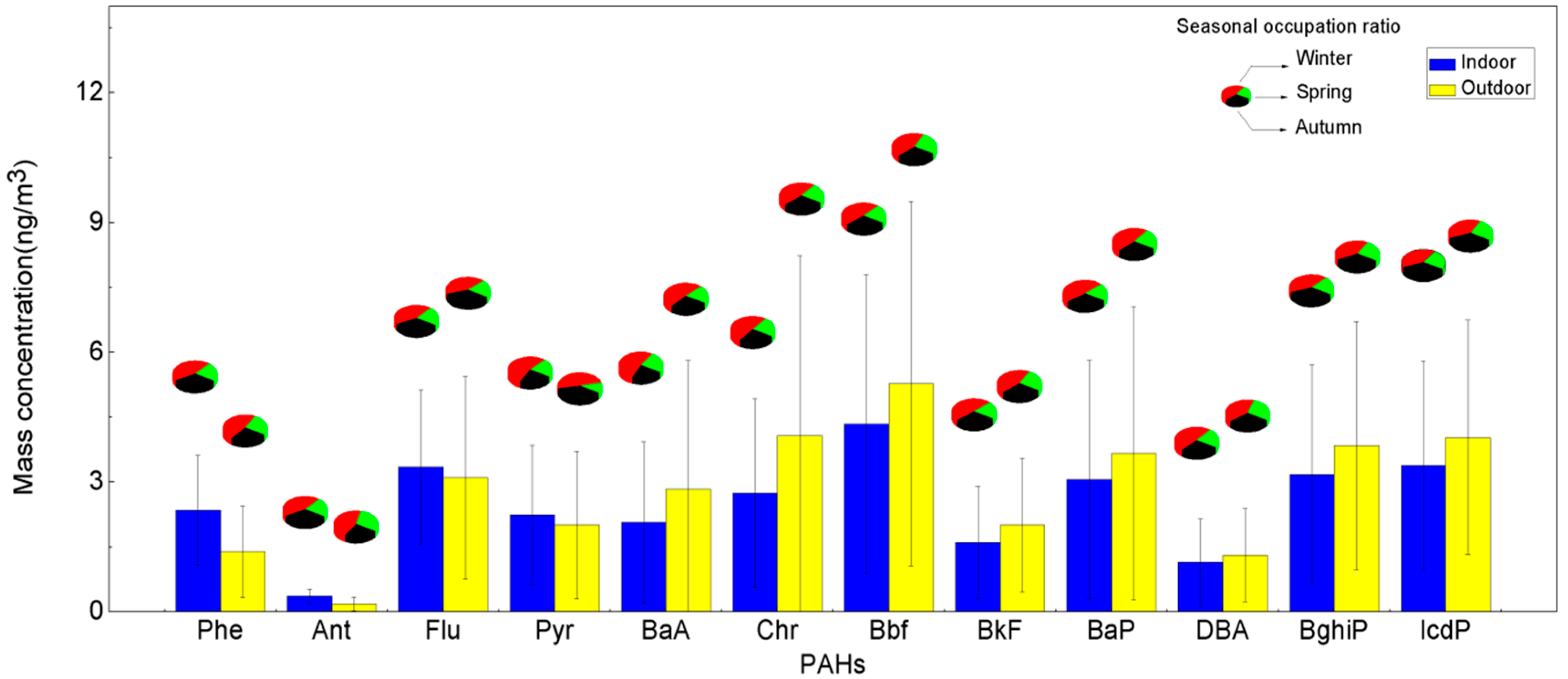
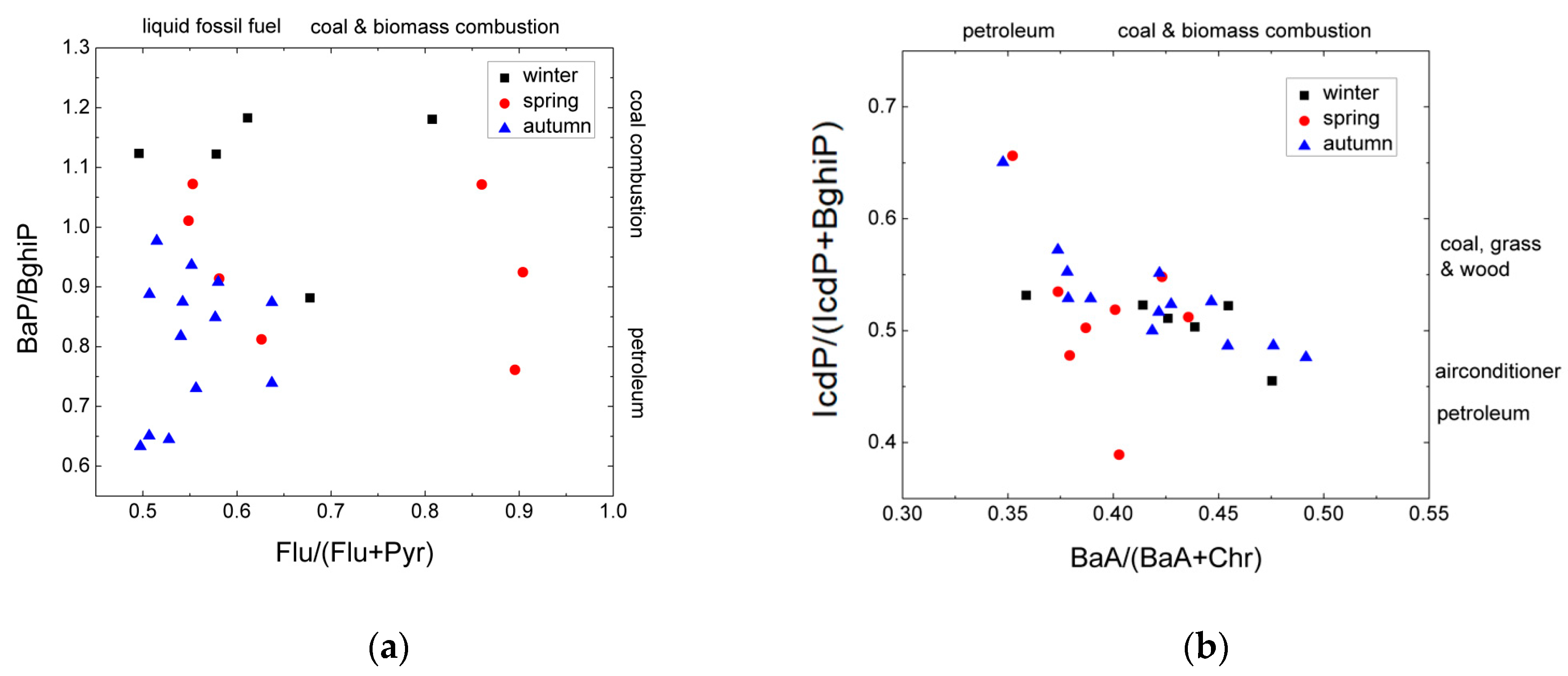
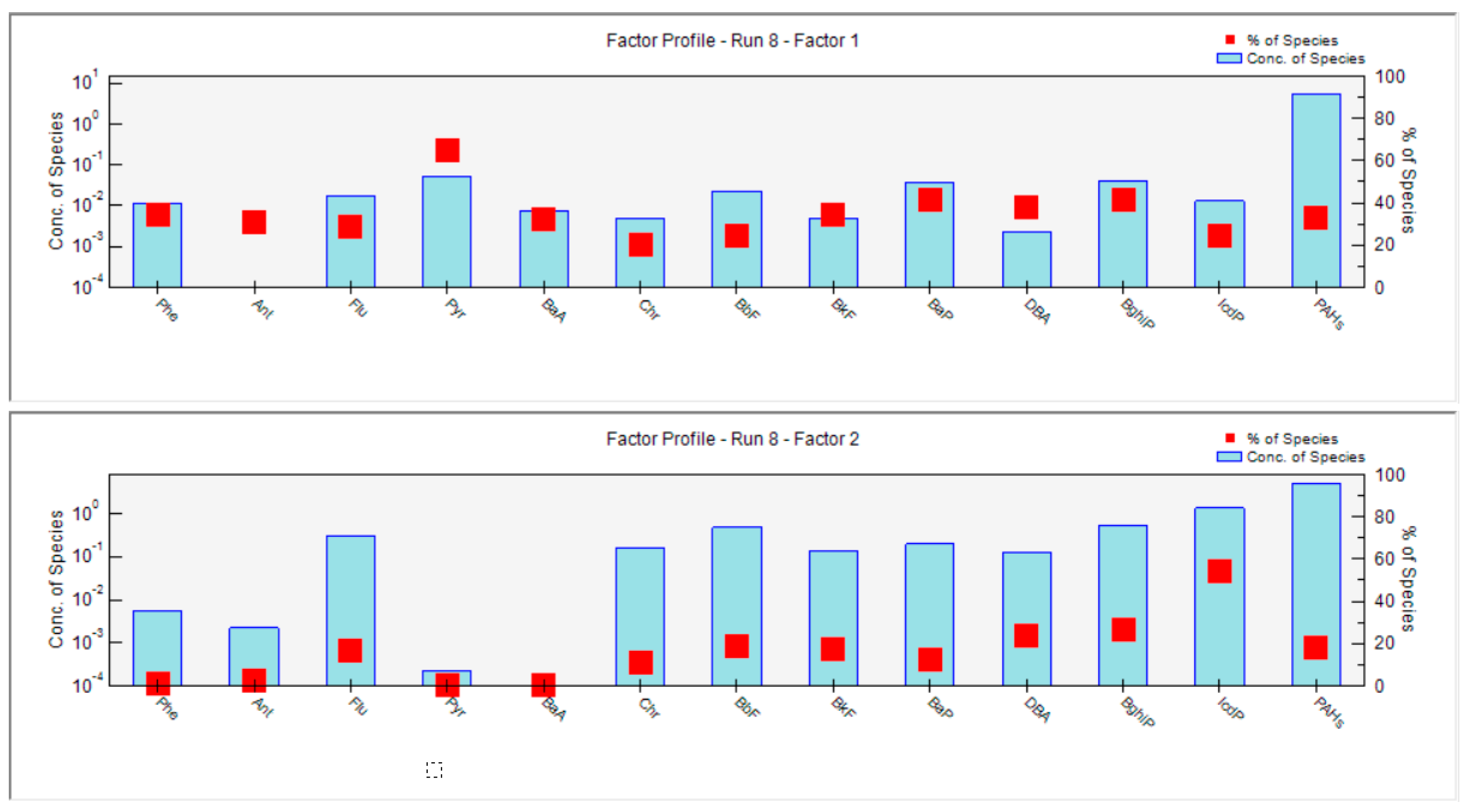
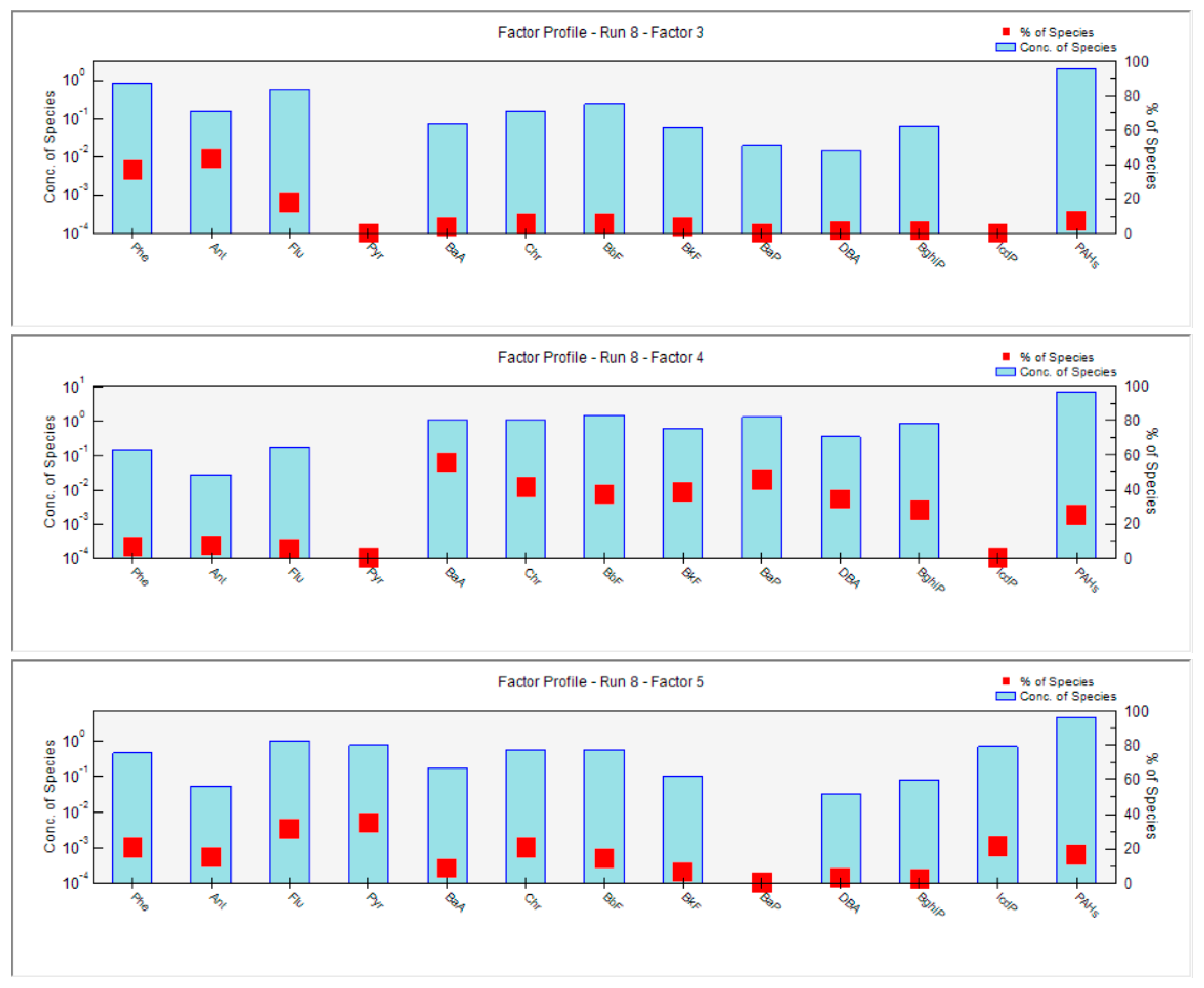

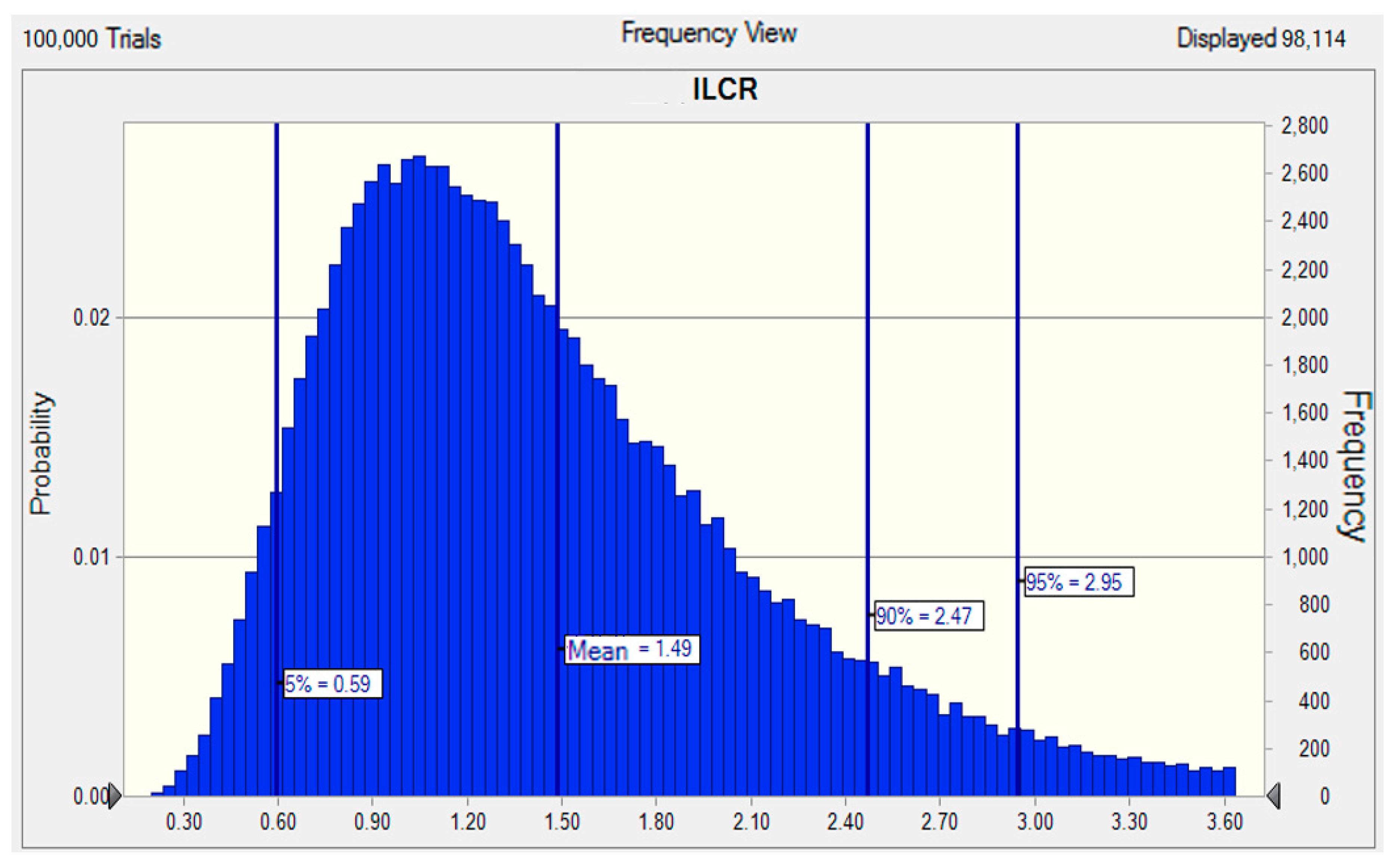
| Sources | IcdP/(IcdP + Bghip) | BaA/(BaA + Chr) | Flu/(Flu + Pyr) | BaP/BghiP |
|---|---|---|---|---|
| Cigarette | 0.55–0.60 | 0.31 | 0.51–0.59 | 1.75 |
| Cooking | 0.4 | 0.54 | 0.69 | 1.61 |
| Coal combustion | 0.38–0.52 | 0.50–0.55 | 0.68–0.74 | 0.9–6.6 |
| Traffic | 0.42 | 0.39 | 0.6–0.7 | 0.3–0.78 |
| Fuel combustion | 0.18 | 0.39–0.60 | 0.38–0.4 | 0.3–0.4 |
| Diesel combustion | 0.37 | 0.15–0.26 | 0.6–0.7 | 0.46–0.81 |
| PAH Species | Chemical Formula | Rings | MW * Groups | TEFs | Average Concentration(ng/m3) | |
|---|---|---|---|---|---|---|
| Indoor | Outdoor | |||||
| Phe | C14H10 | 3 | LMW | 0.001 | 2.34 | 1.39 |
| Ant | C14H10 | 3 | LMW | 0.01 | 0.36 | 0.18 |
| FL | C16H10 | 4 | MMW | 0.001 | 3.35 | 3.10 |
| Pyr | C16H10 | 4 | MMW | 0.001 | 2.24 | 2.01 |
| BaA | C18H12 | 4 | MMW | 0.1 | 2.07 | 2.84 |
| Chr | C18H12 | 4 | MMW | 0.01 | 2.75 | 4.08 |
| Bbf | C20H12 | 5 | HMW | 0.1 | 4.34 | 5.27 |
| BkF | C20H12 | 5 | HMW | 0.1 | 1.61 | 2.01 |
| BaP | C20H12 | 5 | HMW | 1 | 3.06 | 3.67 |
| DBA | C22H14 | 5 | HMW | 5 | 1.14 | 1.32 |
| BghiP | C22H12 | 6 | HMW | 0.1 | 3.18 | 3.84 |
| IcdP | C22H12 | 6 | HMW | 0.1 | 3.39 | 4.03 |
| Number | Date | Cin-PM2.5 (μg/m3) | Cout-PM2.5 (μg/m3) | Number | Date | Cin-PM2.5 (μg/m3) | Cout-PM2.5 (μg/m3) |
|---|---|---|---|---|---|---|---|
| 1 | 10–11 | 73.16 | 90.31 | 15 | 1–9 | 66.42 | 43.35 |
| 2 | 10–12 | 101.88 | 190.12 | 16 | 1–11 | 164.88 | 66.34 |
| 3 | 10–14 | 208.72 | 365.21 | 17 | 1–14 | 154.74 | 88.98 |
| 4 | 10–15 | 206.45 | 242.46 | 18 | 1–15 | 118.18 | 54.78 |
| 5 | 10–16 | 71.32 | 86.43 | 19 | 1–17 | 52.27 | 121.90 |
| 6 | 10–24 | 59.21 | 91.06 | 20 | 3–2 | 54.97 | 112.34 |
| 7 | 10–25 | 67.32 | 84.40 | 21 | 3–5 | 20.98 | 66.91 |
| 8 | 10–26 | 46.14 | 48.97 | 22 | 3–8 | 32.37 | 47.97 |
| 9 | 10–29 | 59.41 | 81.17 | 23 | 3–10 | 47.53 | 123.84 |
| 10 | 10–30 | 53.60 | 32.44 | 24 | 3–12 | 66.31 | 114.33 |
| 11 | 11–2 | 150.96 | 186.20 | 25 | 3–15 | 154.72 | 183.83 |
| 12 | 11–6 | 60.50 | 67.73 | 26 | 3–17 | 161.16 | 174.87 |
| 13 | 11–8 | 116.00 | 147.09 | 27 | 3–20 | 173.24 | 196.06 |
| 14 | 1–7 | 257.64 | 321.88 |
| Number | Date | Cin-PAHs (ng/m3) | Cout-PAHs (ng/m3) | Number | Date | Cin-PAHs (ng/m3) | Cout-PAHs (ng/m3) |
|---|---|---|---|---|---|---|---|
| 1 | 10–11 | 11.22 | 11.89 | 15 | 1–9 | 23.04 | 22.09 |
| 2 | 10–12 | 14.03 | 15.31 | 16 | 1–11 | 38.06 | 38.15 |
| 3 | 10–14 | 20.98 | 15.10 | 17 | 1–14 | 71.47 | 81.10 |
| 4 | 10–15 | 25.00 | 27.44 | 18 | 1–15 | 41.88 | 34.13 |
| 5 | 10–16 | 10.94 | 11.11 | 19 | 1–17 | 64.73 | 85.67 |
| 6 | 10–24 | 23.72 | 24.58 | 20 | 3–2 | 27.06 | 24.79 |
| 7 | 10–25 | 18.38 | 23.69 | 21 | 3–5 | 7.86 | 20.88 |
| 8 | 10–26 | 19.15 | 21.34 | 22 | 3–8 | 8.05 | 6.07 |
| 9 | 10–29 | 31.63 | 41.52 | 23 | 3–10 | 36.65 | 50.58 |
| 10 | 10–30 | 11.92 | 5.72 | 24 | 3–12 | 6.05 | 6.54 |
| 11 | 11–2 | 69.28 | 80.22 | 25 | 3–15 | 41.27 | 54.23 |
| 12 | 11–6 | 29.80 | 32.77 | 26 | 3–17 | 21.91 | 22.14 |
| 13 | 11–8 | 83.03 | 108.41 | 27 | 3–20 | 25.54 | 23.65 |
| 14 | 1–7 | 23.00 | 21.78 |
© 2020 by the authors. Licensee MDPI, Basel, Switzerland. This article is an open access article distributed under the terms and conditions of the Creative Commons Attribution (CC BY) license (http://creativecommons.org/licenses/by/4.0/).
Share and Cite
Ouyang, R.; Yang, S.; Xu, L. Analysis and Risk Assessment of PM2.5-Bound PAHs in a Comparison of Indoor and Outdoor Environments in a Middle School: A Case Study in Beijing, China. Atmosphere 2020, 11, 904. https://doi.org/10.3390/atmos11090904
Ouyang R, Yang S, Xu L. Analysis and Risk Assessment of PM2.5-Bound PAHs in a Comparison of Indoor and Outdoor Environments in a Middle School: A Case Study in Beijing, China. Atmosphere. 2020; 11(9):904. https://doi.org/10.3390/atmos11090904
Chicago/Turabian StyleOuyang, Rentao, Suding Yang, and Linyu Xu. 2020. "Analysis and Risk Assessment of PM2.5-Bound PAHs in a Comparison of Indoor and Outdoor Environments in a Middle School: A Case Study in Beijing, China" Atmosphere 11, no. 9: 904. https://doi.org/10.3390/atmos11090904
APA StyleOuyang, R., Yang, S., & Xu, L. (2020). Analysis and Risk Assessment of PM2.5-Bound PAHs in a Comparison of Indoor and Outdoor Environments in a Middle School: A Case Study in Beijing, China. Atmosphere, 11(9), 904. https://doi.org/10.3390/atmos11090904





